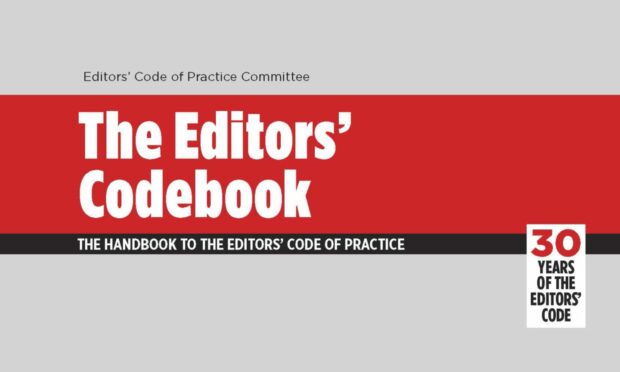One thing I have learned from being an official channel for public views about the P&J is that people are not short of firm ideas about what we should – and more often should not – be able to report.
True, a large proportion are keen to offer self-serving “advice” about why it is wrong for us to expose them for the criminal, corrupt, hate-filled or otherwise anti-social pests they are.
Others though present far more constructive and nuanced arguments about where the boundaries between media freedom and individual rights and privacy should be drawn.
Editors’ Code of Practice is a living, breathing document
Right now, those groups and individuals have an important opportunity to shape our rulebook: a new public consultation on the Editors’ Code of Practice, the bible for almost every newspaper in the land when it comes to ethical standards.
In the last of these columns I began to explore the individual clauses that make up the code, a sacred document a bit like our version of the 10 Commandments, except that there are 16 and – crucially in this case – they are not written in stone.
As the news industry and the world it reports on evolve, so the code adapts, tweaked every so often to keep it “fresh, responsive and relevant”.
One recent change saw mental health explicitly added to the categories of personal information individuals should expect us to show respect for when it comes to privacy.
The Editors' Code of Practice is going under review with a public consultation, which happens every three years. Submissions should go to codereview2023@gmail.com. The last change in January 2021 saw a reference to mental health added to Clause 2 (privacy) https://t.co/EBBkvp6MFk
— Press Gazette (@pressgazette) January 10, 2023
Why? Because charities and others lobbied for it as part of the last of these three-yearly consultations. It is a good example of why they are not merely paper exercises.
While there was never any doubt before then, at least in the newsrooms that I have worked in, that “health” included the mind as well as the body, having it there in black and white serves as a powerful reminder.
(As an aside, if it seems odd that it was not already there, remember that the code was first drawn up in 1991 – a time when the taboo around talking about it as readily as about physical health remained strong. Some might argue that the press played its part in maintaining that status quo. As is often the case though, the industry eventually put itself at the vanguard of breaking the damaging stereotypes.)
Stronger children’s rights
It is by no means the only change to have come about as a direct result of responses to these appeals from the committee that acts as the guardian of the code. The panel is made up of 10 editors – including our editor in chief Frank O’Donnell, three independent lay members and the chairman and chief executive of Ipso, the body which polices press self-regulation.
The several thousand ideas submitted to it in 2017 prompted an extension of the anonymity for children accused of committing crimes – giving protection beyond even what is required by law.
It was spelled out more clearly that people should not necessarily expect things they’ve made public online to remain private. And links were added to the Codebook – the weighty tome on the practical application of the rules that sits, dog-eared from regular use, on my desk and many others – about reporting on suicide and science.
Free – to the right degree
No journalist is keen on feeling constrained. We know a free and fearless media is enormously beneficial to society. The proof is plain to see in countries that seek to suppress it.
Doing the job properly inevitably involves pushing boundaries, intruding into areas some would much prefer stayed private.
Occasionally changes to laws and regulations cross the line and start to impede that work, changes we and others would rightly take the fight to in the name of crucial freedoms and the public interest.
There is a recognition too though that there are lines that can be worked inside of without compromising the need to operate “without fear or favour”. And I have certainly not yet encountered any scenario in which those lines set out in the Editors’ Code have stopped us doing what we need to do.
How to take part in consultation to shape Editors’ Code of Practice
The reason we have a Readers’ Ombudsman role is to make sure we take account of what our readers think – your feedback to these columns has already led to changes in how we do things.
That is why I would encourage everyone with the kind of perspective that rightly gives us pause for thought, to send your ideas to codereview2023@gmail.com by the end of March.


Conversation